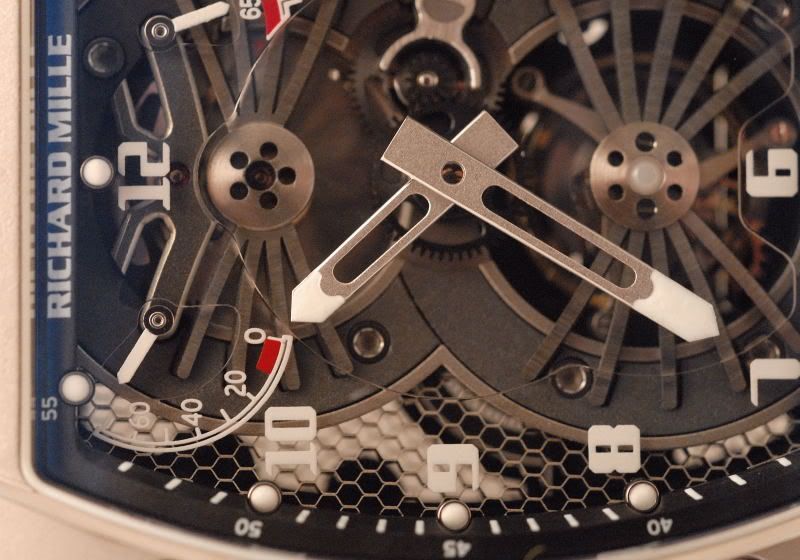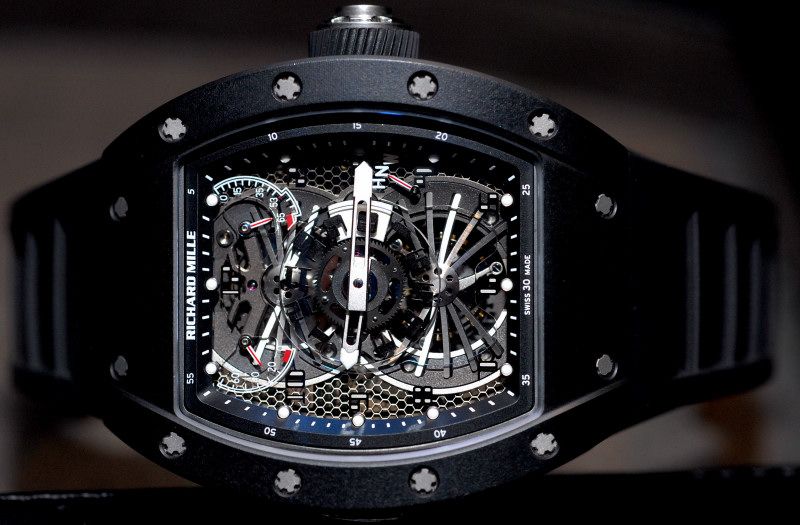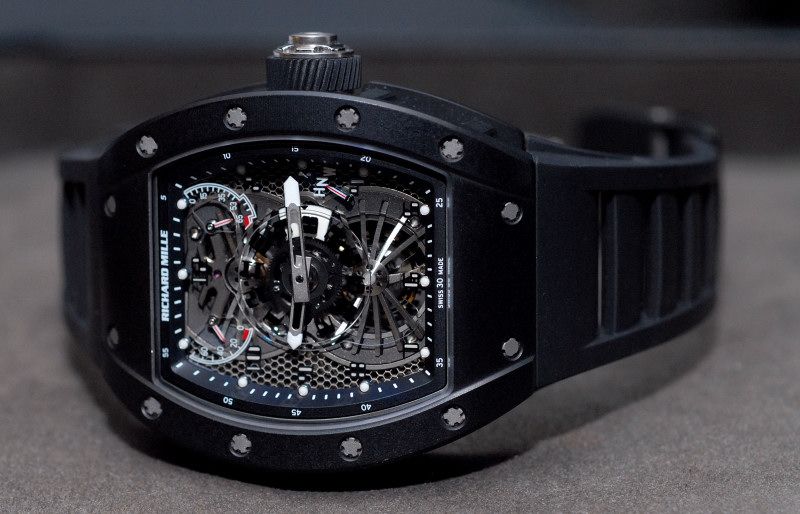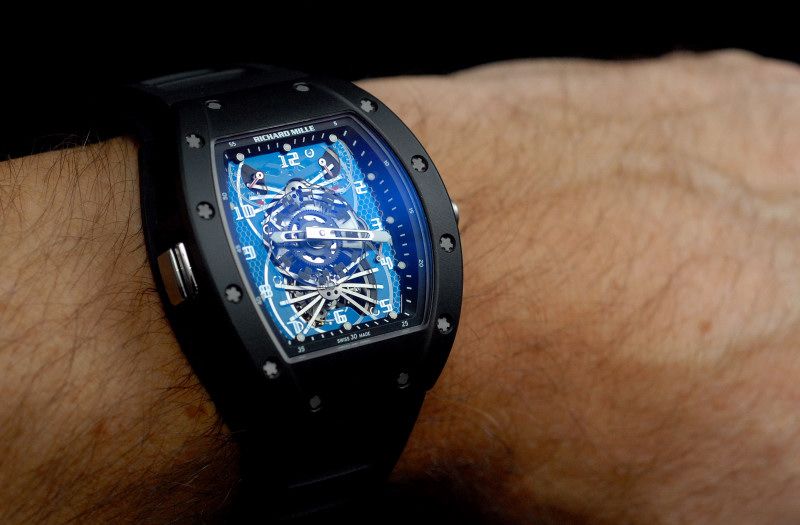
219
3826

“Wings of Desire”: Richard Mille’s RM021/RM022 and Orthorhombic Titanium Aluminide.

[The baseplate for the RM021. As described below, the simplicity of its appearance belies the techniques and technology that underlie its production]
[One of only 5 in the world: this one at Harrods RM Boutique in London, the new stealth watch from Richard Mille – the RM022 Carbon]
Introduced in 2009, the RM021/022 watches were Richard’s new standard tourbillon watches: the ‘basic’ time only and the GMT. And while we had come to expect the innovative and new material science stance from Monsieur Mille, the watch perhaps did not get the attention it deserved. Talking with Yves Mathys (General Manager at Richard Mille Watches SA), he reflects that perhaps it was not the best time to launch a new tourbillon. The series was slow to get started and demand for tourbillons generally in 2009 and 2010 were not as high as usual. Hence the RM021 and RM022 watches did not ‘take-off’ in the market as expected.

It was strange, here was a new design for the Richard Mille tourbillon line, new baseplate material that even now is still somewhat overlooked, new case design, and yet sales were slow. Sales have started to pick up now, especially with the recent limited editions of the RM022 Carbon (with carbon nanofibre parts and carbon nanotubes case). Perhaps here, in this stealth bomber attire (literally – and I will come back to this), the new baseplate material has found a home in the Richard Mille tourbillon series. For while the baseplate looks a simple lattice work of hexagonal metal, the orthorhombic titanium aluminide baseplate is made to the same standards as the metal contained in the stealth bomber wings and engines. The story of this material in the RM021 and RM022 has remained hidden and hopefully this article will shed some light on the missing information. 
Initially, the prototype baseplate was housed in ceramic, but for the limited edition RM022 Carbon, the watch has a carbon nanotube housing. More than we know, this is a watch borne from the aeronautics industry. Unlike some other brands where the pattern might be a façade, something fastened to the baseplate for effect; within the RM021/022 series the honeycombed pattern is the material. Admittedly, the baseplate is unique in its use within the watch industry. Where Richard had started with the carbon nanofibre baseplate and seen others in the watch industry start to use carbon to some degree; Richard moved away and used other lightweight materials that are nonetheless impervious to every day deviations in temperature. 
Frederic Garinaud and Frederic Magnard, the concept engineers behind the use of the orthorhombic titanium material in a baseplate, were both trained in aeronautical engineering. They started with the orthorhombic as a concept piece for a new baseplate having worked on the carbon nanofibre baseplate for the RM006. The orthorhombic material had been shown to Frederic Garinaud at an aeronautics show in 2006 in France and the concept baseplate that was produced was one that would be a ‘true’ baseplate (that supported the movement) and was not there for decoration. 
At the time of seeing the orthorhombic titanium material, it was only two years since the patent was approved (United States Patent 6758388 - www.google.com
What made this material different was obvious for anyone whose first concern was saving weight. Not really needed within a watch, admittedly, but the baseplate did bring with it a new aesthetic. The material itself, titanium aluminide was not a new alloy; or the shaping and combining it with a ‘honeycomb’ structure. What was new was the way the materials were combined with a brasing technique to combine the titanium aluminide structure with the other metals that would be either top, base, or on the side.
Using a metal alloy that was (and is) pure rocket science, the subject of NASA research into an alloy that would allow lighter turbine and aircraft wings, with less corrosive problems, it seemed a strange choice for a base plate. Until you see the watch, the unusual bridges for the main spring and for the tourbillon (that are slanted metal that catch light in different ways) and the base plate itself gives the watch details that at first appearance are missed. This is not a decorative feature but an integral part of the plate itself. The orthorhombic titanium aluminide (orthorhombic TiAl (OTiAl) honeycomb core) has unique properties, one of which is the ability to act as a metal that can be soldered like any other metal. Hence, around the edge of the orthorhombic titanium aluminide is titanium that can be used to mount the movement parts and then the movement into the case.
Reading the patent on the techniques for constructing the material, it seems deceptively simple! Indeed, simply take a “…relatively thick (0.0008 to 0.006 in., preferably about 0.002 in.) metal braze filler foil of an alloy containing copper, titanium, and optionally nickel.” Now comes the ‘mind boggling’ part: “Preferably, the assembly may be heated to a temperature in the range of about 1700 F to 2200 F for a braze soak time of between 1 minute and 150 minutes to cause melting of the metal foil and brazing of the honeycomb core and facing sheet(s) faying surfaces.” Depending on how you want to do this exactly, all the heating and bonding of metal surfaces as described takes place in a vacuum furnace, and the metal surfaces are bonded without cracking. Cooling the metal after heating it to such an extreme temperature requires time. There is also the problem of applying and maintaining the pressure necessary and consistently so that the metals braze with each other. 
So even though the orthorhombic baseplate might look a relatively simple thing, it is not. As some other watch firms have used a façade or pattern that is similar, it is probably lost on most of us (myself included until I started the research for this article) that for the RM021/22 series, the base plate for the watch is constructed in much the same way as the metal wings or parts on a high performance jets. In the same way that Richard had always been concerned with technique, it is the technique of manufacture for the baseplate that is completed in the same way as the wings that control the afterburners on the jet engines. It is the same orthorhombic titanium aluminide that is lies in the small wings, that are heated and cooled to extreme temperatures, and it is the same techniques that are used to construct the baseplates. I would agree that such temperature variations will never be needed in a wristwatch, but the techniques for manufacture are the same. The orthorhombic titanium aluminide is an integral part of the movement baseplate; it is not simply stuck on. It will not corrode or warp over time to temperature variations!
Given the requirements for manufacture, the orthorhombic titanium aluminide baseplates are expensive to manufacture, and in keeping with the carbon nanofibre baseplates, the only place where you can get such a specialized order made is in the US. The orthorhombic baseplates are different from standard baseplate production because each one has to be produced separately. This is not a case of getting a ‘blank’ and placing it on a CNC machine, pressing a button, and getting a baseplate at the end of the machining process. No, this is a highly specialized individually made baseplate for each watch. The profile of the baseplate has even been shaped to resemble that of a wing: fatter in the middle part, thinner at the outer edges. While Richard’s aim is to keep the watch manufacture in Switzerland, in the high technology, very specialized areas, he has to turn to the Aeronautical Space flight specialists, who usually supply to NASA, to produce what is required. From their training, and from their inside contacts in the industry, Messrs Garinaud and Magnard provided the knowledge for the idea and the production of baseplates by the necessary high technology firms.
When they were originally released, the RM021 and RM022 movements with their new baseplate were housed in a white gold case. The case was redesigned from the RM cases that had gone before. The outer ridges for the RM screws were raised, but the inside edges were polished. To Yves Mathys this was one of the real problems with bringing the RM021/22 watches to market. The polished line has to be exact. To accomplish it, new polishing tools, and new methods were employed, and the effect was to accentuate the ridged design of the new case: a little like spoiler wings on Formula 1 cars. 
I thought the RM021 and RM022 watches were stunning new versions of Richard’s base tourbillon models. Basically replacements for the RM002 and the RM003 that had been in the Richard Mille line up (almost) since day one. However, for some reason, the watches did not take a place in collector’s hearts in the same way that the earlier tourbillon models had. Some have blamed a surfeit of tourbillon models on the market (not just Richard’s); others that at the time the effects of the financial fallout were biting in earnest. Either way, the white gold RM021/22 watches have become something of a rarity. For Richard, production will mirror the state of demand, so at the current time, the number of RM021 and RM022 watches in circulation is a low number. With demand for base tourbillon models not as strong as a decade ago, the use of the orthorhombic titanium aluminide baseplate has moved into special editions with low production numbers.
The new form for the case constructed from the carbon nanotube composite, the same material that had been developed for the RM027, provided the special edition watch with a new stealth cloak. It is an interesting fact to note that the B-2 Stealth bomber, with wings made from orthorhombic titanium aluminde, beneath its carbon-fibre composite outer shell, costs twice as much as the weight of the plane if it was made of solid gold. Richard was right about that, it is not the precious metals that make the watch valuable, or the precious stones, but the techniques, finishing, and innovation in the watchmaking. And no doubt, the RM022 carbon costs more than the weight of the watch if it was made from solid gold. With a new outer shell of carbon nanotubes, and a baseplate of orthorhombic titanium aluminide, the new RM022 Carbon really is a stealth bomber of a watch. It looks fairly innocuous on the wrist to the un-informed eye, but that belies the technology, innovation, and the finishing contained in the watch. 
Harrods RM Watch Boutique kindly invited me to view the watch. On the wrist the watch is light to the point of hardly noticing that anything is there. Although not in the same gravity defying class as the RM027, the RM022 Carbon is not far behind. The parts for the GMT tourbillon mechanism are made from anti-corrosive ARCAP alloy and the watch is as near to the weightless feeling that the RM027 induced for a watch with a baseplate and other functions (GMT, power reserve, torque indicator). With the carbon nanotube casing, and in keeping with production numbers for other stealth machines using the same materials, the number is strictly limited (to 5). The watch should be appreciated for the difficulty and uniqueness in the use of the materials. There are not too many flying around out there!
Andrew H This message has been edited by 219 on 2012-10-22 13:50:34 This message has been edited by MTF on 2012-11-02 23:09:14
This message has been edited by 219 on 2012-10-22 13:50:34 This message has been edited by MTF on 2012-11-02 23:09:14

“Wings of Desire”: Richard Mille’s RM021/RM022 and Orthorhombic Titanium Aluminide.

so cool!!

Not sure if the watch is still there. But yes, worth the

Debate in the Spirit of PuristS

MTF - where to start....

I have a lot...

Thanks Daos. There is more to Richard Mille watches than

Exceptional.

Actually, the weight of the watch and the price in terms of gold

Carbon is definitely the way to go.

My bank account does not allow for it either. But for a

Interesting

First, the baseplate, as with the ALUSIC, is in a material

If NASA should ever reactivate . . .

Ahh yes, a plane from my childhood... The pilots would
